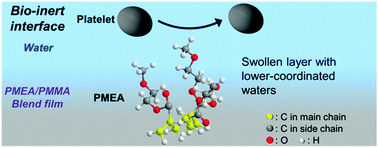In this study, we found that the surface made of a mixture of poly(2-methoxyethyl acrylate) (PMEA) and poly(methyl methacrylate) (PMMA) exhibited excellent blood compatibility by inhibiting platelet adhesion. To obtain a better understanding of this bioinertness, the polymer/water interface was characterized by neutron reflectivity measurements and sum frequency generation spectroscopy, in conjunction with bubble contact angle measurements. Based on the results, we can say that the outermost region of the blend film was reorganized in water. When the orientation of PMEA segments at the water interface became random with increasing immersion time, the fractional amount of lower-coordinated water molecules increased at the interface. Such an interfacial structure caused the suppression of platelet adhesion.

